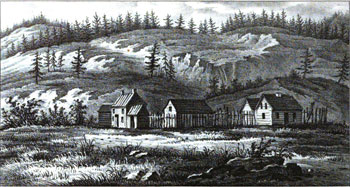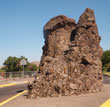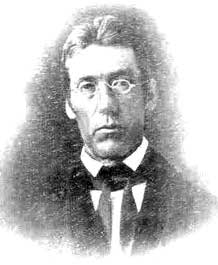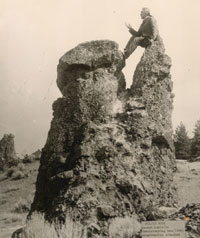 |
Wascopam Mission at the Dalles
illustration by William Tappan and/or George Gibbs |
On March 21, 2013 The Dalles, Oregon, marked the 175th anniversary of the founding of the Wascopam (pronounced Wah-SCO-pum) Methodist Episcopal Mission.
Pulpit Rock, a natural rock pillar, stands as a sentinel overlooking the old Mission grounds at the intersection of East 12th and Court streets. It marks the site of the Wascopam mission. The mission was built Northeast of Pulpit Rock, near Amotan spring, in the area where the current Methodist church and The Dalles Wahtonka High School are located today [2012].
The journals of Rev. Henry K.W. Perkins state the date of their arrival at “Wascopam” as March 21, 1838, although a plaque on Pulpit Rock notes the date as March 22.
 |
| Pulpit Rock today |
Pulpit Rock was never mentioned by any of the missionaries in their journals. Local legend states that Jason Lee preached from Pulpit Rock, through interpreters. That claim has been based on the oral history of two Indians, Joseph Luxlello of the Wisham and Chief White Swan of the Yakamas, who claim they saw Jason Lee preach from Pulpit Rock during camp meetings.
Following the widely publicized “Macedonian Call”, recalling the journey made by four Native Americans to St. Louis to visit William Clark and ask for missionaries and "The Book of Heaven," the Methodist Board of Missions, headquartered in New York, decided to send missionaries to Indian Territory to minister to the native peoples and convert them to Christianity.
 |
| Rev. Jason Lee |
Rev. Jason Lee was ordained as the “Missionary to the Flathead Indians” in 1833. The newly organized Methodist Episcopal Missionary Society sent Lee, along with his nephew Rev. Daniel Lee, lay missionary Cyrus Shepard and two assistants, P.L. Edwards and C.M. Walker, to Oregon to establish a mission. From April to September 1834, Jason and his nephew, Rev. Daniel Lee, along with Shepard, Edwards and Walker, traveled overland with Nathaniel Wyeth and his 70-man party to Oregon.
Jason Lee, as Superintendent of the Oregon Mission, selected a site in the Willamette Valley to establish a mission. The area there was considered “malarial” and both Shepard and Daniel Lee became sickly.
Daniel Lee retreated to Hawaii for his health. The work load fell on Jason Lee, who wrote a letter and sent it back east, pleading for help.
Rev. Henry Kirke White Perkins was accepted as a volunteer to the Oregon Mission in Jan. 1837, and arrived at the Columbia Sept. 4, 1837 as part of the 2nd Reinforcement for the Methodist Episcopal Missions under Jason Lee.
Perkins spent the winter at the Willamette mission, marrying Elvira Johnson on Nov. 21, 1837.
The following spring, Henry Perkins and Daniel Lee traveled by canoes from Ft. Vancouver with the aid of six local Indian guides, and an old chief, Marnicoon. They arrived at the dalles of the Columbia on March 21, 1838 where they were greeted by about 50 Wascopam Indians who had word of their approach.
The word “Wasco” translated means “bowl made of horn” and the suffix “-pam” means “people.” This Native American band inhabited the lands at the foot of the several miles-long stretch of rapids that French-Canadian fur trappers referred to as “les dalles” of the Columbia River.
After two weeks, Perkins returned to the Willamette to fetch his wife, Elvira.
 |
| Rev. Daniel Lee |
Daniel Lee and Henry Perkins built the mission during the scorching summer heat, with the assistance of a hired free mulatto Negro man named Winslow Anderson, a Hawaiian, and the help of some of the local Wasco Indians.
Jason Lee and Dr. John McLoughlin stopped at the Wascopam mission in 1838. Lee was on a return trip to the east coast, where he would lecture about Oregon and urge the formation of an Oregon Territory and immigration by settlers. Lee realized the political balance of power between Britain and the United States for the Oregon territory would be determined in large part by a shift in the population, and his fervent call for settlers helped trigger the Oregon Trail emigration.
One of the greatest challenges faced by Daniel Lee and Henry Perkins was communication with the Wascopam natives, and the ability to explain clearly to them the philosophical tenents of the Bible and Christianity.
The area around les dalles of the Columbia was at the confluence of a great many cultures. Tribes from all around the Pacific Northwest came here to fish and trade, and with them came a variety of languages.
Tribes were determined more by language they spoke than by the territory they inhabited. The Chinook jargon evolved as a pidgin mixture of indigenous languages mingled with French and English as a way to bridge the communication gap. The primary language spoken by the Wascopam was Sahaptin.
 |
Joseph Luxillu At Pulpit Rock
Wasco County Pioneer Association photo collection, WCPA 45-6, Columbia Gorge Discovery Center |
Luxillu was a native of Wisham, a village at the Dalles, on the north side of the Columbia River. His native language was the Walla-walla. As it is quite common for the different tribes to intermarry, he obtained a wife from the Chenooks.
Luxillu and Wapaspa, his wife, lived happily together. Unfortunately, their children all died in infancy.
During the great revival of 1838, Luxillu and his wife experienced the pardoning grace of God, as did a large number of the Indians, both young and old.
Luxillu was one of the faithful few who continued in undeviating fidelity to his profession. In his lodge he was mild and devoltional, faithfully attending to his social duties as a Christian. The family altar was never without the sacrifice of prayer and praise. In the stated prayer-meetings, Luxillu’s voice of confession of Christ was seldom wanting; and his devotional spirit fully evinced his sincerity.
Luxillu was an excellent interpreter. He seemed to catch, as the missionaries never knew any other Indian to do, the spirit of the language communicated to him. When be was absent during the fishing or berry season, away from the stated means of grace, and surrounded with temptations, he stood firm. He always returned rejoicing in the love of God. As might be expected, confidence in his piety was inspired in the minds of his companions, though they were unconverted. His influence for good was extensive. It affected all who knew his spirit and life.
When his teachers left the Dalles for the Willamette Valley, in anticipation of returning to their own country, he accompanied them with a heavy heart.
He had loved them for their work’s sake, and he loved them because be loved Him who had sent them to tell him of the cross of Christ. When, at last, the time came for them to embark for the States, this faithful disciple, like the companions of Paul, accompanied them to the beach, and bade them farewell with many prayers and tears, sorrowing, as did the apostle’s friends, because he thought to see their faces no more.
Source: Sketches of Mission Life among the Indians of Oregon, Zachariah Atwell Mudge, published by Carlton & Phillips, New York, Sunday-School Union, 200 Mulberry-street, 1854.
|
Daniel Lee and Perkins led the work at Wascopam. They worked hard at engaging with the native peoples.
Henry Perkins developed a good grasp of Indian dialects. He began a dictionary, and he kept journals, recording the customs and devastating mortalities of the native peoples, during the 1830’s and 1840’s caused by disease and armed conflicts. By early 1840, Henry Perkins had developed a strong enough command of Sahaptin to sermonize in it.
During Daniel Lee’s absence while visiting the Willamette mission in Nov. 1839, Henry Perkins began having great success. When he returned, Lee was astonished at what Perkins told him. Lee recorded in Ten Years in Oregon, “...Mr. Perkins was found labouring zealously night and day, going from lodge to lodge, praying and exhorting, holding prayer meetings and preaching... Large numbers of the natives attended the meetings as earnest hearers, and several had begun to pray.”
Perkins and Lee were exhilarated. In the winter of 1839-1840 the two carried on a revival, going from long house to long house, contacting the Indians for 50 miles up and down the Columbia river.
Their efforts started out slow. In January, 1840, only one soul out of a village of 300 at Wisham, came to hear them speak the first night. Within four days, nearly the entire village came to hear them. They repeated this wildly successful experience in village after village, so much so that their claims were doubted by the missionaries in the Willamette Valley, who had very little success in their own area.
In April of 1840, an eight-day camp meeting was held just downstream from Wascopam. Lee stated about 1,200 souls were present. This number is significant, given there were only about 1,600 native people living within the Wascopam circuit at the time.
Perkins and Lee were joined, in June 1840 by Henry B. Brewer, a farmer and his wife, Laura, who arrived at Wascopam to help with the farming, remaining until its closure seven years later. They were accompanied by Dr. Ira Babcock, a physician and his wife. Babcock was soon after reassigned to the Willamette Mission by Jason Lee.
On October 11, 1840, Jason Lee arrived for a second camp revival. Perkins noted 400 natives participated in communion, and Lee baptized more than 100 Walla Wallas, but Perkins and Daniel Lee were disappointed because the numbers of attendees were far less than they had been in April.
On March 31, 1842 the last recorded camp meeting was held at Wascopam. Again, the number of people in attendance disappointed Daniel Lee and Perkins. They never again achieved the size of the April 1840 gathering.
In mid-1843 Daniel Lee returned East, because of the ill health of both he and his wife.
The first large wagon train over the Oregon Trail, a migration of over 800 people, arrived at the Dalles mission, in the fall of that year (1843).
Perkins was elated that many of the immigrants were in the habit of attending camp meetings. “We rejoice to hear that three among the thousand souls in the present party are said to be professors of religion. If they arrive with one spark of spiritual life in them, we trust by the blessing of God, we shall succeed in fanning it into a flame.” But the mission was overwhelmed by the needs of the emigrants. On Nov. 24, 1843 Perkins noted: Our station has the usual aspect of a hotel or camp...we could not see them pass hungry and starving...most of our wheat, potatoes and fat cattle we have parted with.”
The costs of the Oregon mission were far greater than the Methodist Board of Missions had expected. They were disgruntled with the fact that for the amount of money spent, the number of native converts to Christianity was less than spectacular. Their expectations had been too unrealistic. They expected the Christian religion to immediately supplant 10,000 years of native tradition, regardless of differences in culture, language, and religious heritage.
In July 1843, they removed Jason Lee from his position as Superintendent of the Oregon missions and replaced him in June 1844 with Rev. George Gary, who moved quickly to sell off mission property.
Henry Perkins became discouraged with the politics being played back East by people who had no real concept of what it took to run the Oregon missions. Upset with Gary’s actions, Perkins sent in a scathing letter dated July 24 threatening to resign. He calmed down, but the die had been cast and to his dismay he learned his resignation had been accepted.
In December of 1844 Henry Perkins and his family departed on the ship the “Peru” and returned to New England.
Alvan Waller and his family came to Wascopam to replace Perkins.
The emigrant flood continued. Over 1,400 people traveled the Oregon Trail in 1844, followed by 2,500 in 1845, most passing through the Dalles and seeking aid at Wascopam mission.
In 1845 Samuel Barlow and Joel Palmer led a party of 3,000 to Oregon. Barlow began building a toll road that year, that still bears his name, around the south side of Mt. Hood. He completed the Barlow Road in 1846, providing Oregon Trail emigrants overland passage into the Willamette Valley without risking death in the treacherous rapids of the Columbia River. Emigrants paid five dollars per wagon on their way to the Willamette Valley.
As the years went on, white migration kept increasing; the little group of missionaries at Wascopam were hard-pressed for supplies to relieve the suffering of the emigrants, who arrived destitute, starved, and seriously ill. The focus of the mission had shifted: from converting the native population into Christians, to serving the great influx of white settlers.
This resulted, in September of 1847, with a request made by Dr. Marcus Whitman on behalf of the Presbyterian American board, to purchase the Wascopam mission property in The Dalles. A draft was drawn of $600 to pay for the fixtures and stock. On the day Whitman gave him the draft, Waller and Brewer left for Vancouver. Whitman left his nephew, Perrin Whitman and Br. Alanson Hinman in charge of the Wascopam Mission and returned to Waiilatpu mission in Walla Walla.
However, two months later on Nov. 29, 1847, Whitman, his wife Narcissa and 9 others were massacred by the Cayuse Indians. As soon as Perrin Whitman heard of the murders, he and his companions at Wascopam Mission fled to Fort Vancouver.
The draft for the purchase of the Wascopam mission was never cashed and in the face of Indian hostilities, the Presbyterian American board pulled out of the region.
Two years later, when the Land Claim act came into being in August 1848, the Dalles City claimed the land as city property and the US Supreme court later ruled the property “abandoned”, and upheld the city’s title.
In a statement by the Supreme Court, “...the appellant [Methodist Episcopal Church] had no title of any kind which could be confirmed and established by the [Land Claim] act of August 14, 1848...Neither of the societies acquired any title under the act of 1848...the release made by the American Board to the appellant in 1859, after Dalles City had entered and paid for the land, and the patent of the United States in 1875...conveyed no rights to the appellant in the lands in controversy.
Oregon Territory was formed in August 1848, with federally appointed Governor Joseph Lane proclaiming Oregon a Territory of the United States on March 3, 1849.
After the Whitman massacre of 1847, hostilities began to grow between area natives and the hordes of white settlers and gold seekers.
The government responded by sending a regiment of Oregon Mounted Volunteers to Dalles City in 1849. Quartermaster Major Osborne Cross recorded in his journal "The March of the Regiment of Mounted Riflemen",
"The Old Mission has gone greatly to ruin. It is composed of a dwelling house, which we now occupied; also three more buildings, one of which had been used as a school-house, opposite the one fronting the river. These buildings would all have made good quarters for a detachment of troops, (which was suggested in my letter to the colonel,) who could have remained here and taken charge of the stores and public property this fall. The buildings rest on the side of the picket work,
which is made of heavy pine logs, brought from the neighboring mountains, where wood for fuel and timber can be procured in great abundance. The outbuildings have all been destroyed, and the whole has been going to decay since the war with the Cayuse nation, at which time it was abandoned. There is a fine spring but a short distance from the house; and the whole valley, which lies between the mission and the river, is finely watered. The soil is very sandy, but, as the valley shows signs of volcanic action, I presume the soil would produce fine grain, particularly oats; for it is not unlike the soil which you meet with at the base of volcanic mountains in Mexico, which yields admirably well.
One of the views here annexed is a small ravine between the mission and the river, where the sides are lined with volcanic rock, and from whence you have a beautiful view of Mount Hood.
The hills on the other side of the river are entirely destitute of wood, which begins to show itself at the bend of the river, below the Old Mission; those immediately in rear have a little scrub oak and pine, but neither is found in great quantities, as much of it has been destroyed.
The mountains immediately in the vicinity, however, are abundantly supplied with pine, which is accessible, and can, at any time, be obtained for building purposes in the greatest abundance."
— From Major Osborne Cross's report to the Quartermaster General, published in Senate Executive Documents, Second Session, Thirty-First Congress, 1850
Two illustrators, William Tappan and George Gibbs, accompanied the Mounted Riflemen. Between them, they sketched several illustrations of the area around the "dalls of the Columbia", including two of the abandoned mission buildings, providing the earliest visual imagery of The Dalles area.
The abandoned mission buildings were in bad shape, and the army later burned them to prevent “hostiles” from using them.
By 1850, supply posts had been established to serve the Oregon Trail emigrants. The small community of Wascopam at the Dalles had grown to about 40 permanent settlers. Within a ten-year span, the permanent residential population would grow to about 2,500 with a “floating tent” population of about 10,000 gold seekers, railroad workers, pioneers and adventurers.
In 1853, the current Methodist Episcopal Church was founded in The Dalles.
The Wascopam natives maintained a non-hostile relationship with the area settlers, perhaps in part due to the friendly relationships established by the missionaries, unlike the area Cayuse and Yakama tribes who went to war in 1855 following the signing of the peace treaties that summer.
Source:
People of The Dalles, The Indians of Wascopam Mission, Robert Boyd, 1996, University of Nebraska.
Supreme Court Reporter, Vol. 2, Cases argued and determined in the United States Supreme Court. October Term, 1882, March-May, 1883. Robert Desty, Editor., Missionary Society of M.E. Church v. Dalles City, April 16, 1883, (107 U.S. 336), Page 672-681.
A Report, in the form of a journal, to the Quartermaster General [Th.S. Jesup], of the march of the regiment of mounted riflemen to Oregon, from May 20 to October 5, 1849, by Major O. Cross, quartermaster United States army. Published in Executive Documents, printed by Order of The Senate of the United States, During the Second Session of the Thirty-First Congress, Begun and Held at the City of Washington, December 2, 1850, in the Seventy-Fifth Year of the Independence of the United States. In Five Volumes. Volume I, containing Document No. 1. Washington: Printed at the Union Office. 1851, beginning on pg. 128-240, accompanied by illustrations by William Tappan and George Gibbs.
Digitized by Google.
http://books.google.com/books?id=hHkFAAAAQAAJ&pg=RA1-PA126&lpg=RA1-PA126&dq=1849+senate+osborn+cross+report+army&source=bl&ots=RjYrmF6K8A&sig=gnc98Ug6fMbFmZXhIUR-lUAAXZg&hl=en#v=onepage&q=1849%20senate%20osborn%20cross%20report%20army&f=false
|

